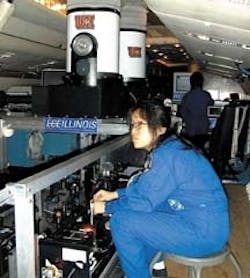
A sensitive laser-radar (lidar) system that was first deployed over Okinawa, Japan to observe meteor trails during the 1998 Leonid meteor shower is now being used by University of Illinois (UI; Champaign, IL) scientists to obtain the first measurements of upper atmosphere temperatures, iron densities, and polar mesospheric clouds over the North and South poles.
"Measuring temperature profiles over the poles is essential for validating global circulation models and for providing a baseline for assessing the impact of global warming over the coming decades," explains Chester Gardner, professor of electrical and computer engineering at UI. "Until now, we were limited to measurements taken with balloon-borne sensors at altitudes of less than 20 miles."
In collaboration with researchers at The Aerospace Corp. (El Segundo, CA) and the National Center for Atmospheric Research (Boulder, CO), Gardner and UI colleagues George Papen, Xinzhao Chu, and Weilin Pan recently developed a more robust lidar system for measuring temperature profiles from the middle of the stratosphere (about 20 miles up) to the lower thermosphere at the edge of space (about 70 miles above Earth; see figure). The system is based on two powerful lasers operating in the near-ultraviolet region of the spectrum and two telescopes to detect the laser pulses reflected from the atmosphere.
The scientists use two techniques to determine temperature. For altitudes up to 50 miles, the amount of laser light reflected from air molecules is measured with a Rayleigh technique and used to derive the temperature profile. For higher altitudes, scattering of the laser beams from iron atoms—deposited in the upper atmosphere by meteoric ablation—is measured. In both layers of the atmosphere, the scientists probe two fluorescence lines of iron—372 and 374 nm. The ground state of the 374-nm line is determined by temperature. By creating a ratio of the signals at the two wavelengths, the temperature can be accurately derived.
In June 1999, the lidar system was flown over the North Pole to obtain temperature and iron-density measurements during a study of the Arctic mesopause temperature. Six months later, the instrument was taken to the Amundsen-Scott South Pole Station where it is now being used to measure the atmospheric temperature structure throughout the year.
"Temperature profiles obtained in the thermosphere over the North Pole on June 21, 1999, and in the mesopause region over the South Pole on January 27, 2000, agreed closely with model predictions," says Garner. "Significant departures from the model were observed during the austral fall, however. On May 8, 2000, for example, the lower mesosphere was about 20°C warmer, and the upper mesosphere was about 20°C cooler than predicted."
Gardner and colleagues also measured the height of polar mesospheric clouds that formed over each of the poles during mid-summer. Unlike the lower atmosphere, the upper atmosphere is colder during summer than in winter. Polar mesospheric clouds form over the summertime polar caps when temperatures fall below -125°C.
Mesospheric clouds are the highest ones above Earth, forming at an altitude of about 52 miles. Their brightness and geographic extent have increased during the past four decades. It is thought that these changes may be related to increasing levels of atmospheric carbon dioxide and methane, which in the upper atmosphere lead to cooler temperatures and increasing levels of water vapor. Surprisingly, the altitudes of the polar mesospheric clouds over the South Pole were consistently 1 to 2 miles higher than those over the North Pole.
"High polar mesospheric clouds may be an indication of stronger upwelling in the summer mesosphere over Antarctica, compared with the North polar gap. Stronger upwelling would result in a cooler mesopause region," says Gardner.
About the Author
Sally Cole Johnson
Editor in Chief
Sally Cole Johnson, Laser Focus World’s editor in chief, is a science and technology journalist who specializes in physics and semiconductors.
